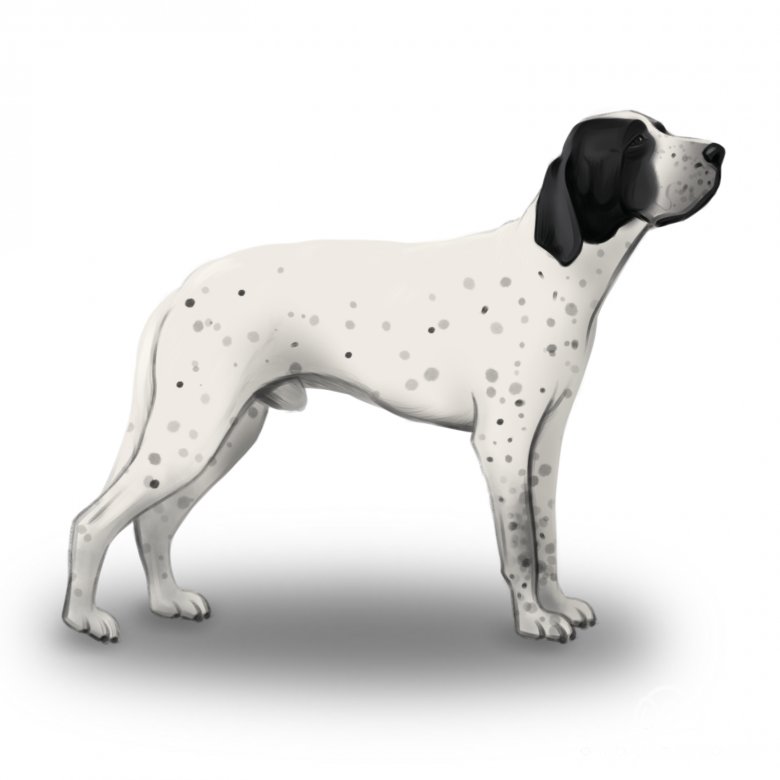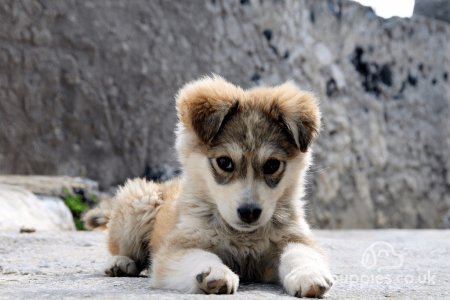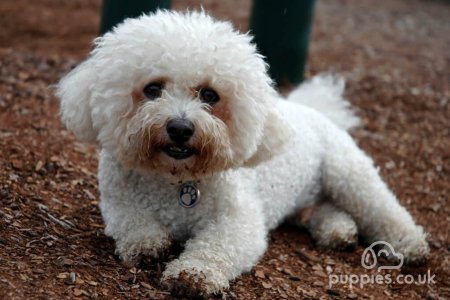Braque d'Auvergne (Auvergne Pointer, Bleu d'Auvergne, Braque Francais)
Overview
The sweet-natured, friendly, and trustworthy Braque d’Auvergne is a lovely gundog breed from the south-central Cantal region of France. Their large size is contrasted with a composed and calm temperament, making them wonderful companions for large homes here in the UK.
Physical Appearance
As a large-sized breed, Braques stand robustly, showing strong bones and musculature without displaying heaviness, as is common to many Braque breeds. Their gait is lively at a gallop, showing their true nature as pointer gundogs.
Dark hazel eyes give Braques an expressive, kind look, whilst their supple ears set at the rear give them an alert expression. Their tails are carried horizontally and are set high.
Braques have a short, shiny coat that is never too hard or harsh in texture or appearance. Colour choices include black with white markings, which can be either flecked or greyed and can be located on the muzzle or ears.
As a pointer gundog breed, Braques resemble German Shorthaired Pointers, Brittanies, and, coat colour aside, Labrador Retrievers and Golden Retrievers.
How big do Braque d'Auvergne dogs get?
Character Traits
The temperament of the Braque d’Auvergne can be summarised as sensitive, intelligent, lively, and obedient. Furthermore, they are loyal and affectionate companions with their owners and their families.
As puppies, early signs of aggression may present themselves through nipping, chewing, or biting. This can be corrected with proper training and socialisation (and it is important to do so through all stages of development). For this reason, first-time owners may wish to consider an alternative breed instead as their temperament may be too much to handle.
Braques can be somewhat independent at times, but they prefer companionship and attention throughout the day. This is made easier by the fact that they are somewhat easy to train, provided that their owner is never too harsh and always encourages and rewards good behaviour.
On account of their large size and cautious temperament, Braques make good watchdogs and may function as guard dogs as well, although other breeds can fulfil this duty far better than Braques.
Are Braque d'Auvergne dogs intelligent? Yes, very.
Are Braque d'Auvergne dogs affectionate? Yes, very.
Do Braque d'Auvergne dogs have high or low energy levels? High energy.
Are Braque d'Auvergne dogs loyal? Yes.
Are Braque d'Auvergne dogs playful? Yes, very.
Are Braque d'Auvergne dogs aggressive? No, but they may nip or bite if improperly socialised.
Are Braque d'Auvergne dogs easy to train? Yes, very.
Are Braque d'Auvergne dogs good guard dogs? Not particularly, but they may be all right as watchdogs.
Ability to Socialise
As with all breeds, socialisation is an important step in the development of Braque puppies into fully-grown adult dogs. The good news is that when properly socialised, Braques tend to get along well with their owners, their families, other dogs, and smaller pets such as cats.
Around strangers, they show caution and may appear defensive until they are accustomed to their company (e.g. a family friend or frequent visitor). Also, keep an eye on young children playing with your Braque d‘Auvergne. Their large size and sometimes boisterous temperament can lead to accidental harm or injury.
As an intelligent breed, Braques can sometimes have a mind of their own, so it’s important that they’re kept on a lead in public spaces such as parks. Provide them with off-lead time in a garden or field where it’s safe and allow them to roam and play, if possible.
Do Braque d'Auvergne dogs get along with other pets? Yes.
Do Braque d'Auvergne dogs get along with other dogs? Yes.
Are Braque d'Auvergne dogs good with kids? Yes.
Are Braque d'Auvergne dogs good with strangers? Yes, but they may be cautious at first.
Lifestyle Suitability
Whilst many pointers and gundogs can tolerate living in smaller homes or even apartments, Braques should always be welcomed into large homes, preferably with large gardens that are fenced off to give them ample room to roam and to claim as their own territory. When raised in a large home with plenty of space, Braques are happiest.
Braques are not known to be hypoallergenic as they do shed, although less than most other breeds due to their short coats. They do not drool much nor do they tend to bark very much at all, making them fairly easy to live with as companion pets.
First-time owners may wish to consider a different breed since Braque d’Auvergnes have a temperament that requires patience and discipline that comes with experience.
Overall, Braques can adapt well to various environments and are perfectly suited for the climate and weather here in Britain.
Are Braque d'Auvergne dogs good for first-time owners? No.
Are Braque d'Auvergne dogs hypoallergenic? No.
Are Braque d'Auvergne dogs prone to drooling? No.
Are Braque d'Auvergne dogs a good breed for apartment living? No.
Do Braque d'Auvergne dogs shed a lot? A low to moderate amount of shedding.
Do Braque d'Auvergne dogs bark a lot? No, not much.
Can Braque d'Auvergne dogs be left alone at home? Yes, but only for short lengths of time.
Can Braque d'Auvergne dogs handle the heat? Yes.
Can Braque d'Auvergne dogs handle cold temperatures? Yes.
Are Braque d'Auvergne dogs sensitive to loud noises? Yes.
General Health & Health Issues
In general, Braque d’Auvergnes have an average health ranking when compared to other breeds. They do suffer from some hereditary health problems and are prone to developing joint and bone problems due to their large size.
In particular, Braques tend to suffer from bloat, bone problems, and eye problems. Most common health problems that Braques tend to suffer from can be tested for and diagnosed at routine visits to the veterinarian’s clinic.
Some common problems include:
Progressive retinal atrophy (PRA): this degenerative disease affects the photoreceptor cells in the eyes of dogs such as the Braque d’Auvergne, which can progressively degenerate over time and lead to blindness;
Cataracts: another eye condition that may affect your Braque is the onset of cataracts, or a cloudy filmlike appearance in the eyes. Surgery can treat cataracts, but there is no way to treat them otherwise;
Hip dysplasia: this joint problem affects the ability of your Braque to stand and perhaps to move around, causing anything from discomfort to pain and lameness of the leg;
Ectropion: the outward folding of the eyelids, ectropion, is somewhat common to Braques.
How long do Braque d'Auvergne dogs live? - 12-14 years
Exercise & Play Time
As an energetic pointer gundog breed, Braques have very high exercise requirements. No less than two hours should be devoted every day to playing and exercising with your Braque d’Auvergne.
Start off with a brisk morning walk, then spend no less than an hour every afternoon or evening playing outdoors, ideally off-lead in a safe location such as on your property. With an excellent sense of smell and a high prey drive, Braques naturally love to chase and catch, which is a great reason to pick up a ball or simply a stick to have them let out their pent up energy.
Moreover, Braques naturally like to navigate through watercourses in pursuit of their prey, which sometimes may include waterfowl such as ducks or birds. Even if they aren’t used for hunting purposes, they should be permitted to roam and play around the water. Just make sure to have them thoroughly dried off afterwards.
How much exercise does a Braque d'Auvergne dog need? - At least 2 hours per day
Do Braque d'Auvergne dogs like water play? Yes, they are naturally great swimmers.
Nutrition & Feeding
Braques aren’t particularly known for being fussy eaters, although it’s important that owners nevertheless provide them with a healthy feeding regimen broken up into 3-4 feedings daily.
Ensure that their diet consists of healthy fats and proteins, but avoid allowing them to overindulge as they are known to develop bloat later on as they age. A healthy diet rich in nutrients, minerals, and vitamins will go a long way towards promoting excellent health.
Should you wish to consider pursuing an alternative diet, such as raw food or cold-pressed dog food, consult your veterinarian first to make sure that such diets are appropriate and that your feeding quantities are consistent with the breeder’s as well as throughout the development stages of your Braque d’Auvergne.
Are Braque d'Auvergne dogs prone to weight gain? Yes, especially as they age.
How much should I feed a Braque d'Auvergne puppy? About 290-590g per day, in 3-4 sessions.
How much should I feed an adult Braque d'Auvergne dog? About 300-410g per day, in total.
Care & Maintenance
Thanks to their short, clean coats, Braques are easy to maintain and groom. All that’s needed is occasional brushing to keep their coats in excellent condition.
Emotionally, Braques do require attention and affection from their owners. They should never be left alone for too long, nor should isolation become habitual as they can develop naughty behaviours such as chewing or biting.
- Grooming: once per week, brush down your Braque d’Auvergne’s coat and follow up with chamois leather to promote a healthy, shiny coat.
- Emotional care: Braques can be left alone, but only for short periods of time. Try to ensure that someone is always home to keep their company.
History of the Braque d'Auvergne
Native to the mountainous south-central Cantal region (in historic Auvergne) of France, the Braque d’Auvergne is an ancient breed that dates back no less than two centuries (from what is known).
Bred for hunters and by hunters, the Braque d’Auvergne was likely bred from multiple pointer breeds with oversight from the Knights of Malta. It is possible that his ancestors include the Pyrenean Braque and the Gascony Pointer. In French, braque means ‘point’ and the Braque d’Auvergne is amongst the oldest known breeds of pointer in the world.
The Braque d’Auvergne has been recognised by the Federation Cynologique Internationale as a gundog breed in 1955. Since 2016, the Kennel Club has also formally recognised this breed.
Interesting Facts About Braque d'Auvergne Dogs
The Braque d’Auvergne is beloved by many owners in the UK but still remains relatively unpopular outside of his native France.
The Knights of Malta may have begun breeding the Braque d’Auvergne after their expulsion from Malta by Napoleon and their subsequent settling in Auvergne’s monasteries.
In France, the Braque d’Auvergne is called the Bleu d’Auvergne ‘blue of Auvergne.’
Getting a Braque d'Auvergne Puppy
Despite their widespread popularity in their native France, the Braque d’Auvergne remains relatively rare in the UK and elsewhere. This means that it may be difficult to find one to purchase or adopt, so we recommend you consult our buying guide and to ensure that you only purchase from reputable breeders in the UK. If you would like to purchase a Braque d'Auvergne, we only list reputable breeders near you.
How much does a Braque d'Auvergne cost to buy? - Over £600.
How much does a Braque d'Auvergne cost to feed? - An adult Braque d'Auvergne costs about £1.50-£1.80 per day to feed.
How much does insurance for a Braque d'Auvergne cost? - About £25-£60 per month.
Sensible alternatives to purchasing a new Braque d'Auvergne puppy include rescue and adoption.
Additional resources can be found via Braque d'Auvergne registries and associations such as:











